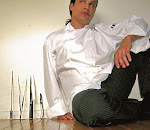Salads usually reach their highest consumption during summer. Falling into a salad rut seems to affect almost everyone. Re-examining the structure of a salad is one way of changing up the norm. Borrowing ideas from different countries like Thailand, Vietnam, Poland and Turkey are great ways to inspire one's self for new tastes.
If we look at vinaigrette and dressing composition, we can change the base of these to integrate more flavor. Instead of using a basic formula of 1 part acid and 3 parts oil, we can start with 1 part herb puree, 2 parts oil and 1 part acid. This slight change can drastically change the flavor of a vinaigrette in a new way.
Wednesday, June 25, 2008
Wednesday, June 11, 2008
BLOOD ORANGE CAVIAR? I'LL EAT IT


*Frothy Iberico ham, tomato confit, pinenut oil, smoked salt, sweet basil pearls*
With a new age of modern cuisine in the midst, chemistry is playing a more "star" role in cooking. With the introduction of various seaweeds and food chemicals, we can alter food in ways never before possible. Using sodium alginate, sodium citrate and calcium chloride together, we can make caviar or pearls out of many various liquids. We can have a similar effect by using reverse spherification with sodium alginate and calcium gluconate, this is best for liquids carrying dairy or high amounts of alcohol. With some simple knowledge and practice, almost anyone can jump into the future, or at least the food can!
Friday, May 2, 2008
Making Poultry Sing

*Spice Duck breast, beet, pear and fennel relish, Barberry Barolo emulsion and scallion butter polenta*
Poultry is a big part of American cuisine. Even though chicken is available in every restaurant, deli and grocery store, it seems to sometimes suffer from some basic rules that make it actually flavorful, tender, and moist. Whether roasting a whole chicken or just a breast or legs, they all require an understanding of anatomy and temperature to precisely capture it's flavor.
A few of the unsung heroes like Duck, Quail and Squab offer complexity and dimension to the poultry world. A rare breast of squab, a quail in rose petal sauce or duck confit, who can deny the magic of poultry.
Saturday, March 29, 2008
A Different Approach To Fish


Toro tuna, Soffrito ice cream, ginger oil, ponzu water gelee
Steamed arctic char, spiced duck confit, onion flan cremeaux, dried cherry syrah butter, Napa cabbage gnocchi
Sometimes a very fresh piece of fish doesn't need alot of ingredient clutter to barricade it's pristine taste. Where different schools of thought have their own views on this, I like to experience new flavor combinations or directions to fish. Knowing the fat content is one process on dictating it's technique for cooking the fish. Fish with a high fat content such as salmon, tuna, Alaskan halibut, or arctic char can benefit from slow roasting, oil confit cooking, or pan roasting. A low fat fish such as flounder, sole, striped bass, or red snapper could benefit from a low heat steaming or a cold poaching method.
Whatever the cooking method, being aware of the internal temperature is crucial. The best way of determining this is using a digital thermometer. If you do not have one, try not to use your finger and push the flesh of the fish. Fish can be quite delicate and this action may damage the fish. Alternately, use a thin metal cake tester. Measure the distance from the edge of the fish to the center. Gently insert the skewer and leave for 3 or 4 seconds. Pull out the skewer and place it under your bottom lip. The skin here is sensitive to temperatures. If the skewer is cold, the fish is still raw. If is is warm, the fish is cooked perfectly. If the skewer is hot, the fish is most likely overcooked. Always allow the fish to rest for 5-10 minutes to ensure it's moistness. Ideal internal temperatures should be
135F (57C)-140F (60C).
Subscribe to:
Comments (Atom)

